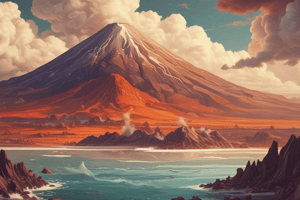Podcast
Questions and Answers
What is the main function of the conduit in a volcano?
What is the main function of the conduit in a volcano?
- Carrying magma from the chamber to the crater (correct)
- Creating volcanic features
- Determining the eruption's style
- Storing molten rock
Which geological feature is responsible for storing molten rock before it reaches the surface in a volcano?
Which geological feature is responsible for storing molten rock before it reaches the surface in a volcano?
- Vent and Crater
- Plate Tectonics
- Conduit
- Magma Chambers (correct)
What is the role of plate tectonics in the generation of magma for volcanic eruptions?
What is the role of plate tectonics in the generation of magma for volcanic eruptions?
- Melting and magma formation (correct)
- Determining the eruption's style
- Storing molten rock
- Creating volcanic features
Which zone in a volcano is responsible for the point where magma and gases exit the Earth's surface?
Which zone in a volcano is responsible for the point where magma and gases exit the Earth's surface?
What determines the eruption's style and strength in a volcano?
What determines the eruption's style and strength in a volcano?
In which regions are volcanoes predominantly formed due to subduction zones?
In which regions are volcanoes predominantly formed due to subduction zones?
What type of volcanic eruptions are common at Mount St. Helens and Santorini?
What type of volcanic eruptions are common at Mount St. Helens and Santorini?
How do volcanic ash clouds impact the atmosphere?
How do volcanic ash clouds impact the atmosphere?
What gases do volcanoes emit that can influence climate?
What gases do volcanoes emit that can influence climate?
What scientific approach combines geology, geophysics, geochemistry, and remote sensing in studying volcanoes?
What scientific approach combines geology, geophysics, geochemistry, and remote sensing in studying volcanoes?
How are explosive eruptions different from non-explosive eruptions?
How are explosive eruptions different from non-explosive eruptions?
Which method involves analyzing the composition of magma, gas, and ash samples to understand volcanic eruptions?
Which method involves analyzing the composition of magma, gas, and ash samples to understand volcanic eruptions?
Flashcards are hidden until you start studying
Study Notes
Exploring Volcano Science: Unraveling the Fury and Fascination of Earth's Eruptive Landforms
Volcanoes are natural marvels that have captivated humanity since ancient times. These dynamic geological features, shaped by the Earth's restless mantle, offer a window into our planet's inner workings. Let's delve into the world of volcano science, exploring the mechanisms that drive eruptions, the ways volcanoes shape landscapes, and the vital role they play in our environment.
The Anatomy of a Volcano
At their core, volcanoes are complex structures that form where the Earth's crust is weakened. They consist of three main zones:
- Magma Chambers: Residing deep beneath the surface, magma chambers are reservoirs that store molten rock before it rises to the surface.
- Conduit: A tunnel-like passageway that carries magma from the chamber to the crater. The size and shape of the conduit determine the eruption's style and strength.
- Vent and Crater: The point where magma and gases exit the Earth's surface, creating the characteristic volcanic features we see.
Driving Forces: Plate Tectonics and Magma Generation
Volcanoes are primarily associated with the boundary zones between tectonic plates. As these plates collide, grind, or diverge, the Earth's mantle is forced upward, causing melting and magma formation.
- Subduction zones: When one plate dives beneath another, the rising magma creates volcanoes like Alaska's Aleutian Range and Japan's Ring of Fire.
- Divergent plate boundaries: Where plates move apart, magma from the mantle fills the widening gap, creating mid-ocean ridges.
- Convergent plate boundaries: When plates collide, magma forms in a process called subduction-related volcanism, creating volcanoes like the Andes and the Cascade Range in the Northwest United States.
Understanding Volcanic Eruptions
Eruptions occur when magma and gases reach the Earth's surface. The style of an eruption depends on factors like the magma's composition, gas content, and the shape and size of the conduit.
- Explosive eruptions: When magma and gas mix, they form low-density, frothy magma called pyroclastic material. Such eruptions are common at volcanoes like Mount St. Helens and Santorini in Greece.
- Non-explosive eruptions: These occur when a viscous magma flows steadily from the volcano, such as at Alaska's Redoubt Volcano.
The Impact of Volcanoes on the Environment
Volcanic eruptions release vast amounts of gases and particulate matter into the atmosphere. While these emissions can alter the climate and cause short-term disruptions, they also contribute to the Earth's long-term geochemical balance.
- Ash clouds: These clouds can scatter sunlight, cool the atmosphere, and affect weather patterns.
- Greenhouse gases: Volcanoes emit large quantities of CO2, methane, and other greenhouse gases that can influence climate.
- Sulfur dioxide: This gas reacts with water vapor in the atmosphere to form acid rain, which can affect ecosystems and agriculture.
Volcano Science in Action
Investigating volcanoes requires a multidisciplinary approach, combining geology, geophysics, geochemistry, and remote sensing techniques. Volcanologists use a wealth of tools and methods to study these dynamic systems.
- Geophysical methods: Measuring seismic, electromagnetic, and gravity signals to monitor volcanic activity.
- Geochemical methods: Analyzing the composition of magma, gas, and ash samples to understand the source, composition, and nature of eruptions.
- Remote sensing: Using satellite and aerial imagery to monitor volcanic activity and map hazardous areas.
As our understanding of volcano science deepens, humanity will continue to harness the knowledge gained from these dynamic landforms to better predict and mitigate volcanic hazards. With this knowledge, we can continue to safely explore and appreciate the awe-inspiring beauty of the world's volcanoes.
Studying That Suits You
Use AI to generate personalized quizzes and flashcards to suit your learning preferences.



